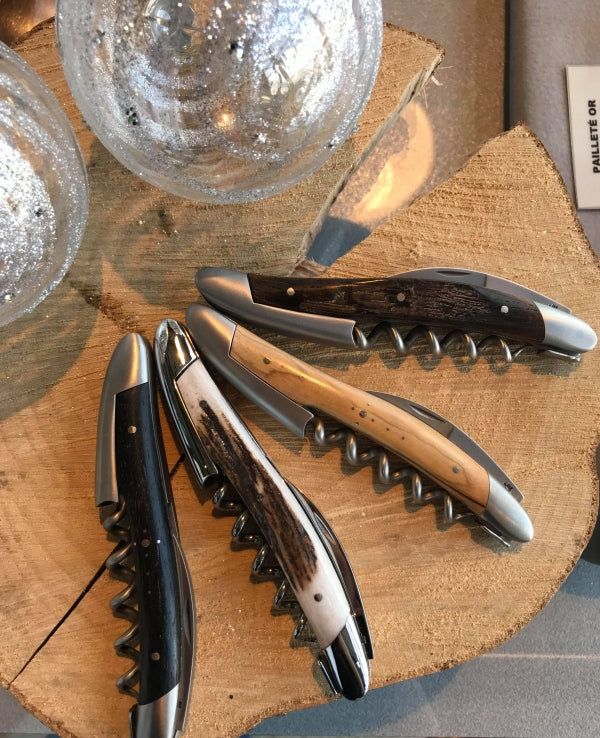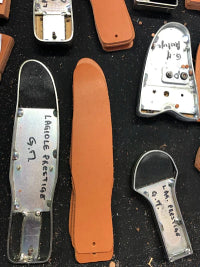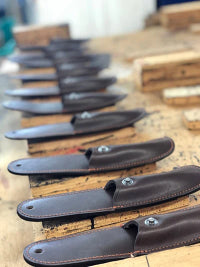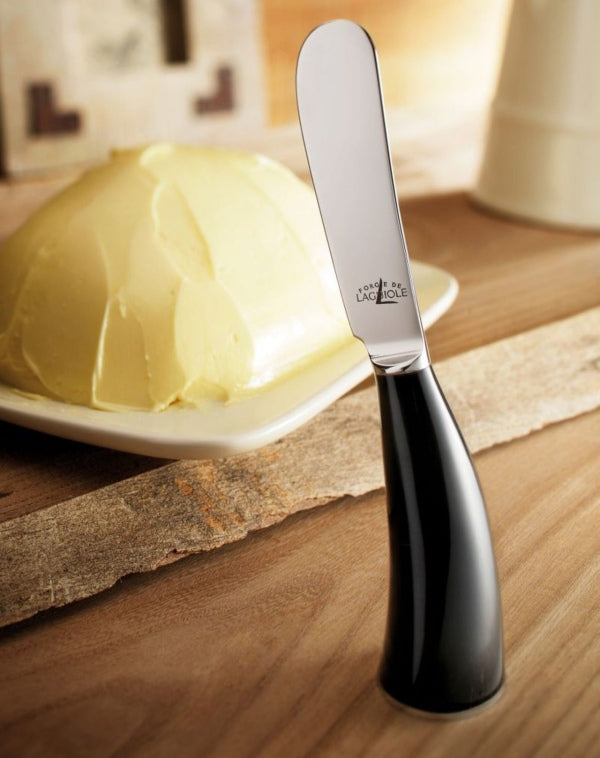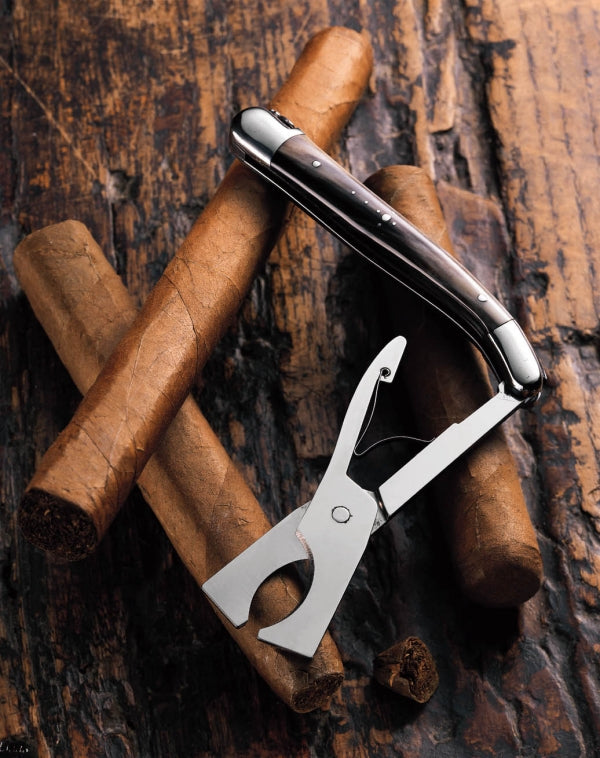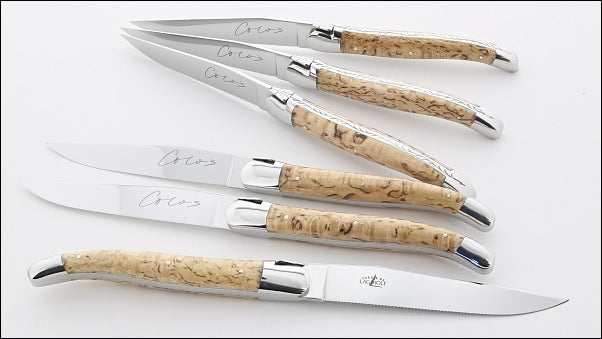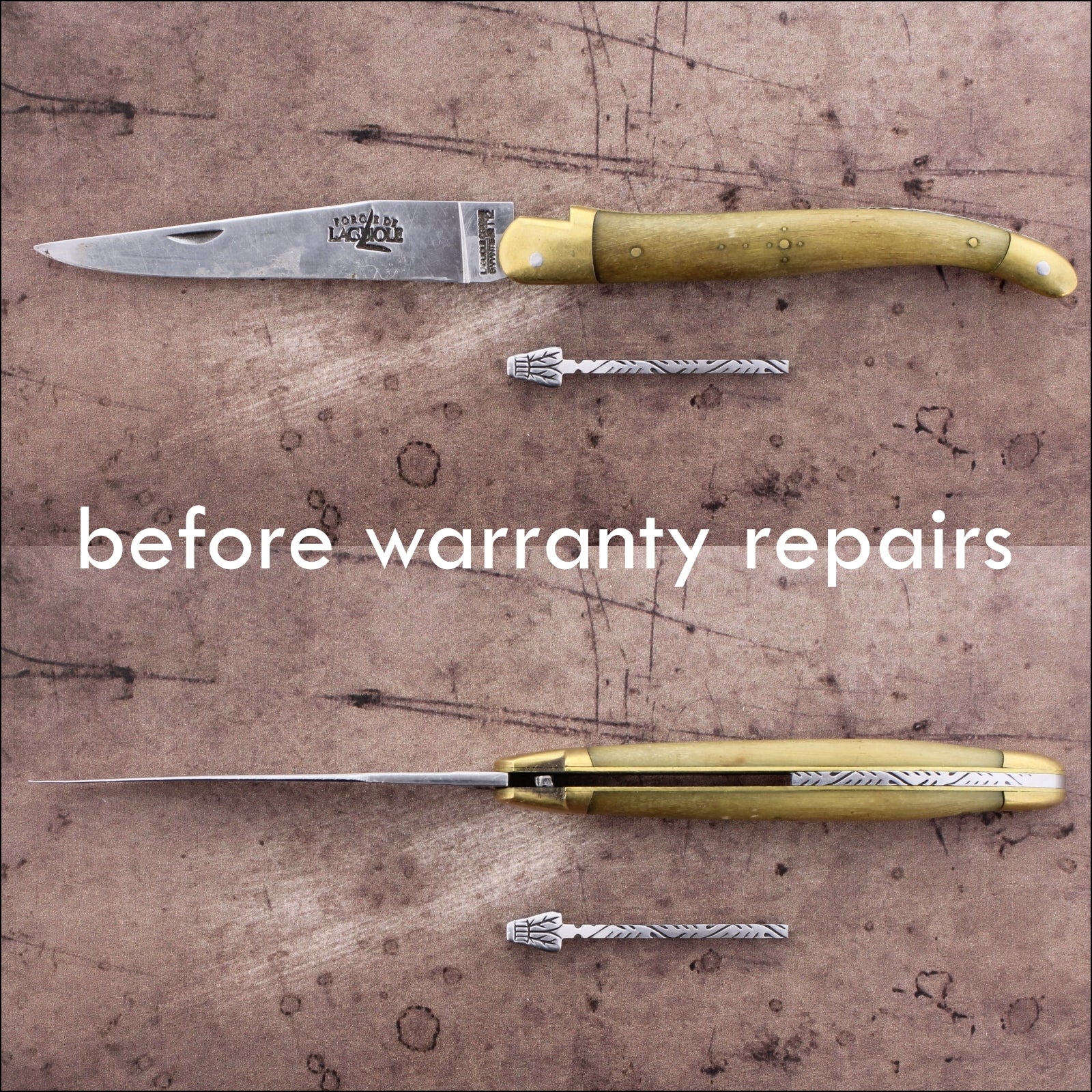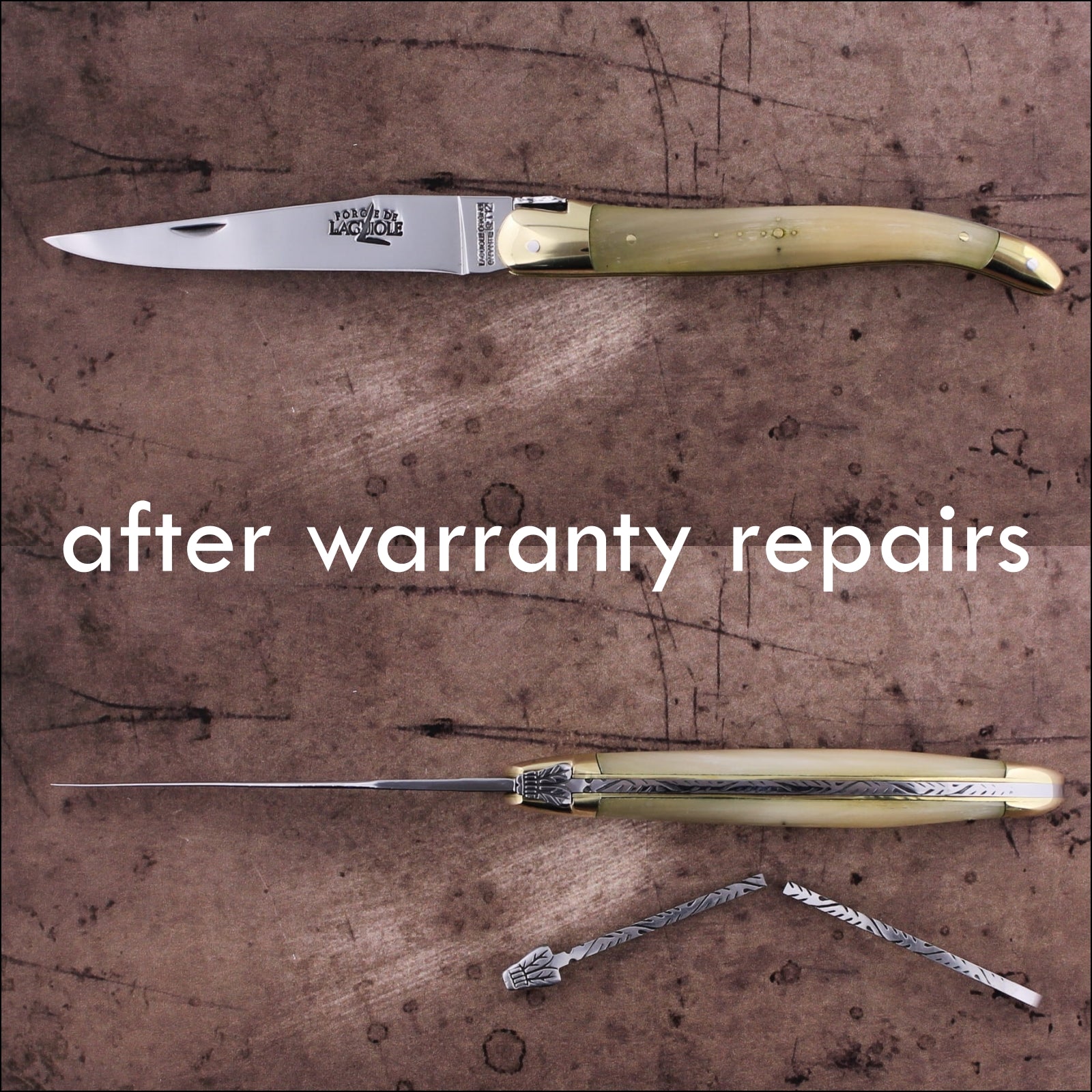HOW DO I RECOGNIZE A GOOD LAGUIOLE POCKET KNIFE?
First and foremost it is important to be aware that Laguiole knives, sometimes called "bee knives" are not made by a single manufacturer, it is not a brand of knives but rather the name of a small village in the department of Aveyron in France. The village of Laguiole is where the famous Laguiole style of cutlery we know today was created.
The Laguiole knife style originated in the quaint village of Laguiole, but sadly, the name was never trademarked. Consequently, it has become part of the public domain. This means that anyone can label various cutlery items as "Laguiole," regardless of whether they're made in France or even exhibit the characteristic Laguiole design.
As of 2024, no regulations govern Laguiole cutlery. The name "Laguiole" is available for use on any cutlery items by anyone and can be manufactured worldwide. With this knowledge, it's apparent why this style of cutlery appears in numerous big-box stores at astonishingly low prices. As the saying goes, "You get what you pay for." We frequently receive calls or emails regarding knives falling apart after a few months of use. Such knives are mass-produced in Asia or France. Laguiole Imports does not endorse these manufacturers; all Laguiole knives on our site are meticulously handcrafted and are of the highest quality, keeping nearly 200-year-old traditions alive.
SHOULD I PURCHASE A KNIFE THAT HAS A PRESSED HORN HANDLE?
Although we don't usually discourage anyone from making certain choices, this is an exception! Please avoid purchasing a Laguiole pocket knife with a pressed horn handle, particularly if you intend to keep it for an extended period. Ensure that the handle material is made of HORN TIP, not PRESSED HORN, regardless of where you purchase your knife.
Why is this crucial? Only the last 4 or 5 inches of a horn are solid like wood or metal; the rest is hollow. To utilize the hollow part, the horn must be cut in half, steamed and compressed to flatten it. However, the horn possesses "shape memory," and over time, it will attempt to revert to its original rounded shape. This can cause the knife handle to lose its shape and display gaps. Pressed horn is inexpensive, which is why low-cost Laguiole knives use it. Retailers offering such knives may be uninformed or unconcerned about your long-term satisfaction with the product.
WHY ARE HANDLE MADE FROM HORN TIP A BETTER CHOICE?
The tip of the horn is derived from the final 4 or 5 inches of a prominent, large horn. It's processed by cutting small bars and attaching them directly to the handle. Unlike pressed horn used in low-quality Laguiole knives, horn tip doesn't require heat treatment. This material is the toughest, densest part of the horn, with only two knives crafted from a single horn tip.
Notably, esteemed French cutlers like Forge de Laguiole and Fontenille Pataud don't utilize pressed horn handles. They prioritize maintaining their reputation for excellence over selling inferior knives. Laguiole Imports also refrains from offering knives made of pressed horn.
CAN YOU RETURN A KNIFE YOU BOUGHT IN FRANCE?
We certainly hope so! However, the retailer may require you to cover the return shipping costs (around $20-50 USD). Keep in mind that just because a French knife was bought in France, it doesn't guarantee high quality or complete manufacturing within the country. (more on this here).
Numerous French-based "Laguiole" websites offer items like garden tools, scissors, and barbecue accessories. Adding a "bee" to these products doesn't signify origin or quality. The items in question are likely mass-produced in China, India, or Pakistan.
Laguiole Imports only offers knives that are 100% made in France. In addition, we offer free no questions asked 30 days returns on non engraved goods.
SHOULD THE KNIFE BE INSCRIBED WITH "FRANCE" OR "MADE IN FRANCE"?
Any of the 2 versions must be inscribed on a Laguiole knife if it is purchased from a retailer in the United-States or Canada. This is a customs requirement that was implemented years ago to help prevent miss representation of the country of origin on pocket knives.
If you just purchased a Laguiole pocket knife from a U.S retailer and it does not have "France or Made in France" inscribed on it and you care for its origin contact the retailer for an explanation or just send it back for a refund. Additionally, although it is not a custom requirement one should expect any other cutlery items such as corkscrews, spoon, forks, etc.. to be inscribed with the country of origin "France."
All Forge de Laguiole cutlery items sold by U.S. retailers will be discreetly engraved with "France" and are made in the village of Laguiole. However, if the same item was purchased from a retailer or website that is located outside of the U.S or Canada it may not be inscribed with the country of origin. Please contact us if you have any doubts regarding a "Laguiole" product, we will gladly provide you with an unbiased opinion.
ASK QUESTIONS TO THE RETAILER!
Be cautious of websites that make it difficult to find their contact information. Their address, phone number, and email should be straightforward to locate. If a "Contact Us" page only asks for your information without providing the retailer's details, it should raise a red flag.
Find out where the Laguiole manufacturer is located. A retailer who cannot answer your questions or won't seek answers from the manufacturer doesn't merit your business. Feel free to email - support@laguiole-imports.com - or call us at 888-899-1172 for any "Laguiole" inquiries. Note: Some manufacturers employ persuasive phrases like "the genuine Laguiole" but fail to provide relevant details about the product's background and quality, nor clarify whether they manufactured it themselves! Stating that they make/sell authentic Laguiole knives simply because "Laguiole" is printed on the blade doesn't guarantee the knife's origin.
A good knife maker will include his/her name or company logo.
The knife blade features a distinctive marking, which may be accompanied by a certificate, or at least display the cutler's logo and origin. A lack of identifying information indicates poor quality. Keep in mind that labels such as "genuine" or "best quality" do not guarantee excellence.
FORGER BLADES - WHAT'S THE CATCH?
Some manufacturers use the term "Acier Forge" (forged metal) or place stickers that imply their knives are forged. In reality, they often refer to just specific parts, like the bolsters, while placing the "forged" label on the blade. They use the term generally, without specifying that the blade – the most crucial part of a knife – is not forged but made from stamped sheet metal, often stainless steel (12c27 for high-end brands). That said, stamped blades made from high-quality stainless steel are still suitable for knife-making. However, it's worth noting that forged blades are superior and more expensive to produce.
Forge de Laguiole is the only Laguiole manufacturer in France that forges all pocket knife blades in-house. They own and operate the forge, which is why they're called "Forge de Laguiole." If you're in the southwest of France on a Thursday, stop by the forge and see for yourself. Thursdays are when FDL forges blades, though any day of the week offers free guided tours. Still, forging day is the most interesting. More about forge blades here.
HOW CAN YOU TELL A WELL-MADE LAGUIOLE KNIFE FROM ONE OF POOR QUALITY?
A particular brand-name engraved into the knife is no guarantee of quality, nor is an expensive-looking style of packaging! Examine your purchase carefully and ask the vendor about its qualities. If your vendor knows his/her stuff, you'll find out all you need to know.
The most genuine Laguiole knives are of course made in Laguiole and it takes a long time to handcraft each knife. If you see a Laguiole sold for a low price, that means that it is "mass produced" in France or sadly some other countries. There are more knockoffs on the market than truly French handmade Laguiole knives.
Judging the technical quality of the knife is harder if you're not used to it, but checking it over carefully is a good idea anyway:
If the knife has a pleasing aesthetic appearance (without any plastic embellishments!), "weighs" in hand and has a nice feel to the grip, you're on the way to buying a decent product. Look for the thickness and solidity of all metal components including massive, and not hollow, bolsters at the tips of the handle. Next, check that the blade opens easily and that it is perpendicular to the spring (hold it up in front of you and squint upwards along the length - you should see a straight line).
When you close the blade again, it should not knock or catch against the base of the spring and should slide easily back into place.
The plates covering the sleeve of the knife should be well-fitted. Check that there aren't any little spaces between the plates and the bolsters corners (the metal edges at the top and tail of the knife), which are a sign of a bad fit. The decorated part of the spring should be well embedded in the crux of the blade so that your finger doesn't catch on it when the knife is open. The decoration of the spring should be slightly different on each knife, even if they are of the same design - these small irregularities are a good sign that the knife is hand-made. It doesn't necessarily mean that the knife you want to buy is not a good one if it doesn't check out against any of the above: but it does mean that the knife isn't of the highest quality.
ONE CRAFTSPERSON, ONE KNIFE!
Only top Laguiole manufacturers adhere to the ancestral traditions of the original Laguiole knives. Completing a single-piece Laguiole knife requires over 100 intricate steps. When a manufacturer claims that each knife is "handmade" by the same artisan, it refers to "assembly, shaping, and finishing." The artisan does not forge their own blade, bolsters, or stamp the liners. Instead, they gather all necessary "raw" components for the knife project and skillfully assemble and shape the handle material. For the "collector" series, the spring and bee are entirely hand-chiseled, taking approximately one hour for these two tasks.
WHAT IS A "FORGED BEE & SPRING"?
You can identify a forged bee by examining its connection with the decorative spring. If there are no gaps, it's likely that the bee and spring were crafted from the same metal piece. A soldered bee can be recognized by a straight gap where the bee meets the top of the spring.
Most inexpensive Laguiole pocket knives, feature "soldered bees" models. Soldering the bee to the spring is a time and cost-effective method, resulting in lower prices for these knives. Fun fact: the original Laguiole knives had forged bees.


